Math centers or workstations where kids are all involved in different activities are a fundamental part of many elementary classrooms.
But centers are also a tremendous amount of work for the teacher, as both differentiation and assessment can be time-consuming and difficult. Are the kids really learning? Are the activities on an appropriate level for each student? How can you tell without grading fifteen different types of activities?
I replaced math centers in my classroom with a 10-minute daily partner game time, and it’s one of the most powerful strategies I’ve found for getting kids to construct knowledge and think deeply about math concepts.
How is a differentiated math partner game time different from math centers?
Kids can pair up and play a game with a partner in either setup. But usually, when students are in centers, you the teacher are working with a small group. Since you’re busy teaching, it’s hard to tell whether the rest of the class is actually learning anything in their centers or if they’ve just mastered the art of looking busy.
During math partner games, however, you are not responsible for small group instruction, so you’re free to facilitate students’ thinking and engage kids in conversations about what they’re learning.
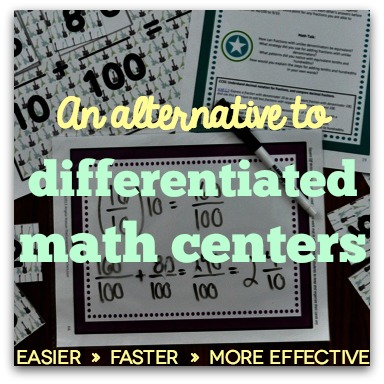
What makes a differentiated math partner game time so beneficial?
Having the whole class play the same game at the same time allows you to conduct mini-lessons/strategy discussions around shared experiences before and after gameplay.
And because the whole class is playing the same game at the same time, you can be 100% focused on observing your students during play and pushing their thinking. You get to watch and engage with students as they actively construct knowledge through collaborative hands-on activities.
How do I make time for differentiated math partner games?
A whole class partner game time can be completed in less than half the time that centers or workstations usually take. It’s a great way to break up long periods of direct instruction with guided practice and meaningful opportunities for students to explore and talk about math concepts.
In my 90-minute math block, for example, I was required to do standardized test prep/spiraling review practice with the kids for 20 minutes at the start of the math period. I chose to follow that with 10 minutes for math partner games, and then launched into my math concept/skill lesson for the day. The active, hands-on partner games were the perfect way to clear students’ heads and let them have some fun.
How many times do kids play the same game?
Generally, students play the same game for an entire week so you have lots of targeted opportunities for identifying and addressing misconceptions and scaffolding student learning.
The repetition also gives students time to master the rules of the game–and that’s where the magic happens. Once kids understand the basics of how to play, they really start focusing on the targeted math skills, determining patterns and strategies, and engaging in higher-level thinking during the discussions.
A good math partner game is open-ended and allows kids to construct their own knowledge. This example is from my Geometry unit.
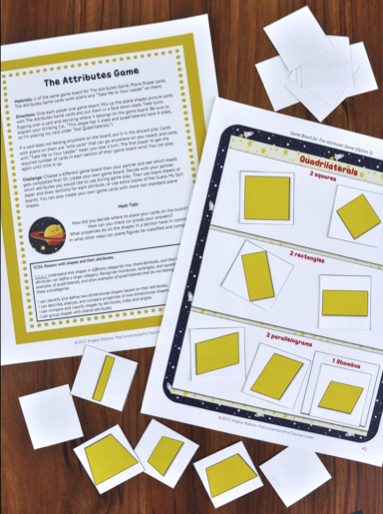
How are kids paired up?
I recommend that math game partners be selected by the teacher (rather than self-selected) so that students are paired homogeneously. This is important because if you have heterogeneous pairs (mixed ability levels), the less advanced child will lose frequently and get frustrated. Kids are just like we are as adults–it’s only fun to play a game if you regularly experience success and feel like you have a fair shot at winning.
Partner 1 is responsible for getting all the game materials from the front of the room, and Partner 2 is responsible for returning them after game play. I usually set a timer for one minute and teach kids to have everything in its place and be ready to work when the timer goes off. This routine makes set up and clean up super quick.
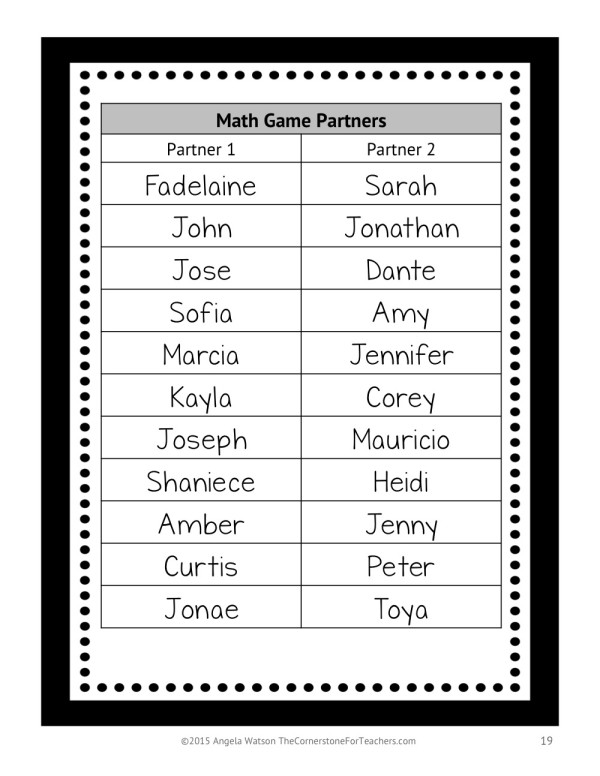
This list of partners is always displayed for the kids’ reference. I make changes to the partner list based on my observations and student input. I’ve found that some kids want to keep the same partner for months, but most kids want to change partners every few weeks, and I try to accommodate them either way so they enjoy the games more.
Is it really differentiated practice if all the kids are playing the same game?
Yes! Differentiation is another reason why I think it’s better to pair kids with similar ability levels for math partner games. You’ll be able to spend more time supporting your struggling students since they’ll be working together. And having your highest-performing kids paired together will be extremely valuable for them because they can play quickly and enjoy being challenged in a way that doesn’t always happen during mixed-ability cooperative activities.
I often differentiate the materials I give each pair of students. For example, below-grade-level students might use a 6 sided number cube (die) during game play, while above-grade-level students might use a 12 or 24 sided cube and play the same game with higher numbers.
I also include a challenge activity in each game which I assign to certain pairs of students for differentiation. Other pairs can choose to do the challenge if they have time, and usually by the last two or three days of the week, most students are ready to try the challenge unless they haven’t yet shown proficiency with the basic level of game play.
Additionally, I include “Math Talk” questions with my games and have students reflect in a conversation or via their math journals. These are open-ended questions that are naturally differentiated.
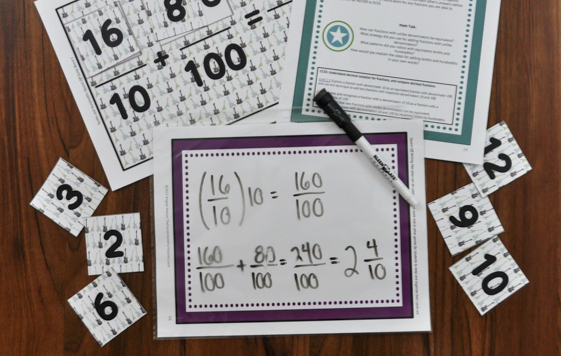
How do I introduce a differentiated math partner game to my class?
This is where math partner games and center time may differ: you as teacher MUST model how to play the game FIRST.
While it’s tempting to skip the demonstration, it makes a HUGE difference in the quality of strategical thinking and conversations you’ll get from your students.
Use the partner games to model mathematical thinking/reasoning and draw attention to the math strategies you want students to use.
Introduce one game to your students each week. During the modeling, you can demonstrate the basics of the game by playing against a student volunteer. I use a document camera to help with this, so the class can see the game pieces as we play. I then ask two other student volunteers to play the game for a couple of minutes in front of the class.
Right after the modeling/demonstration, release students to try playing the game with their partners. If you see a lot of kids making the same mistakes or demonstrating major misconceptions, end the game play time a little early. Talk about it afterward, and do more modeling the next day.
When you first introduce a game at the beginning of the week, you’ll start your math partner game time with around 5 minutes of modeling. By mid-week, you can start the time with a mini lesson focusing on the higher-order thinking skills you want students to develop.
What am I as the teacher doing during game play?
In just this one 10 minute time period, you can accomplish so many different things:
- Observe students as they actively construct knowledge
- Take anecdotal notes and/or informally assess children in meaningful contexts
- Model logistical thinking and encourage math talk before, during, and after game play
- Reinforce basic concept knowledge through game play with below-grade-level students
- Support students who struggle with cooperative learning and social problem solving skills
- Challenge high-achievers and push their thinking
How do I give closure and assess the math partner game time?
You can end the math partner game time with a whole-class debriefing session that can go pretty in-depth since all the kids were practicing the same skills through the same game and have shared experiences.
Students can talk about what strategies worked well and which didn’t. Students can also reflect on these questions in writing (i.e. in math journals), or by talking with their partner (or with a different partner in a think-pair-share activity.)
You can pose particular scenarios that might arise during game play and have students suggest strategies for solving them, or mention a challenge that one team of students experienced and have students talk about what they would do.
How do I make my own differentiated math partner games?
I’ve created the FREE cards below which you can use to start creating your own games:
These cards are perfect for all kinds of open-ended, differentiated partner games.
What if I don’t have time to make high quality math partner games?
YOU don’t need to spend hours planning out and designing rigorous math games that cover all the standards–I’ve already done the work for you!
I’ve created ready-to-use math partner games for every Common Core domain (except Measurement and Data) for grades 1-5. These games allow students to practice ALL the standards in multiple ways to ensure they truly master the concepts. Even if your school doesn’t use the CCSS, these games still cover the basic skills and concepts that are taught at the elementary level, and you’ll see the alignment very easily.
The games are $1 each, and are bundled according to skill: Fractions, Geometry, Operations and Algebraic Thinking, and Number and Operations in Base Ten (Place Value).
Each bundle of games features:
- Higher-level thinking and critical thinking skills (not just rote practice)
- Hands-on activities which allow kids to actively construct knowledge: no worksheets!
- Options for open-ended game play so that students are not “finished” until time is up
- Challenge activities to extend game play and/or differentiate it
- Math Talk questions/prompts to encourage students to analyze strategies and reflect orally or in writing about what they’re learning
Click through the slideshow to see the games for each domain and grade level, or click here to view them in my store:
Already purchased the games? Get the updates free! You now get a .zip folder with purchase that includes individual PDFs for each game. If you only want to print and use one game at a time, you can easily print just the PDF with that game’s instructions and materials. Go into your TeachersPayTeachers account and view your purchases, then re-download the games to access the update.
How do these game work in real classrooms?
These games have been used and loved in thousands of classrooms around the world! Here’s what other teachers are saying:
These games have really enhanced my students’ understanding of place value. They have thoroughly enjoyed playing them. Instructions are clear and games are easy to make. Thanks! – Cathy H.
Best games ever. My 5th graders finally understood fractions after playing these thank you!!!!!! – The Whimsical Teacher
My students don’t even realize they’re learning while they are playing games! Thank you! – Ally Blackwell
This is terrific! I really like all of your information at the beginning for how you use these games for instructional purposes with the gradual release model. Thanks! – Jania D.
The game sets are easy to put together and no-nonsense. The students have enjoyed playing the games, and they play even during “indoor” recesses. – Anonymous Buyer
Definitely worth it so I can spend more of my Christmas break with my family. Saved me a ton of prep time. Thanks! – Zephyr
Great games! Very engaging! Makes practicing these skills a lot more enjoyable for my struggling students – Britta B.
I love how all these games can be played over and over again rather than just once and the question are rigorous. – Katelynn T.
Wonderful games that kept my student engaged for long periods of time with challenging problem solving and critical thinking skills. – Tracy N.
My students love these games, so often I hear, “Math is fun!” Can’t get better than that! – Anonymous Buyer
Fun, creative and interactive, with lots of use of math vocabulary for the students. – Anonymous Buyer
So helpful to have these games to reinforce and differentiate groups! Thank you! – Dayna D.
This sounds great, but isn’t it too late in the year to start partner games?
Nope–this is actually the perfect time to introduce something fun and new to your students. They’ve already (mostly) gotten the hang of your regular classroom routines and are ready for a different challenge. Differentiated math partner games are a great way to break up the monotony of your regular math lessons.
Plus, kids LOVE to play these games! If you have students that dislike math or struggle with it so much that they rarely get any enjoyment from their assignments, these games will allow them to experience success and see the creative, open-ended, and enjoyable aspects of math concepts…maybe for the very first time.
For me, student engagement is at an all-time high when kids are playing differentiated partner games–that 10 minute block might be the highlight of the day for your students!
Have you tried differentiated math partner games in your classroom? Share your questions and experiences in the comments below–I’d love to help!

Angela Watson
Founder and Writer
Sign up to get new Truth for Teachers articles in your inbox
Discussion
Leave a Reply
OR

Join our
community
of educators
If you are a teacher who is interested in contributing to the Truth for Teachers website, please click here for more information.











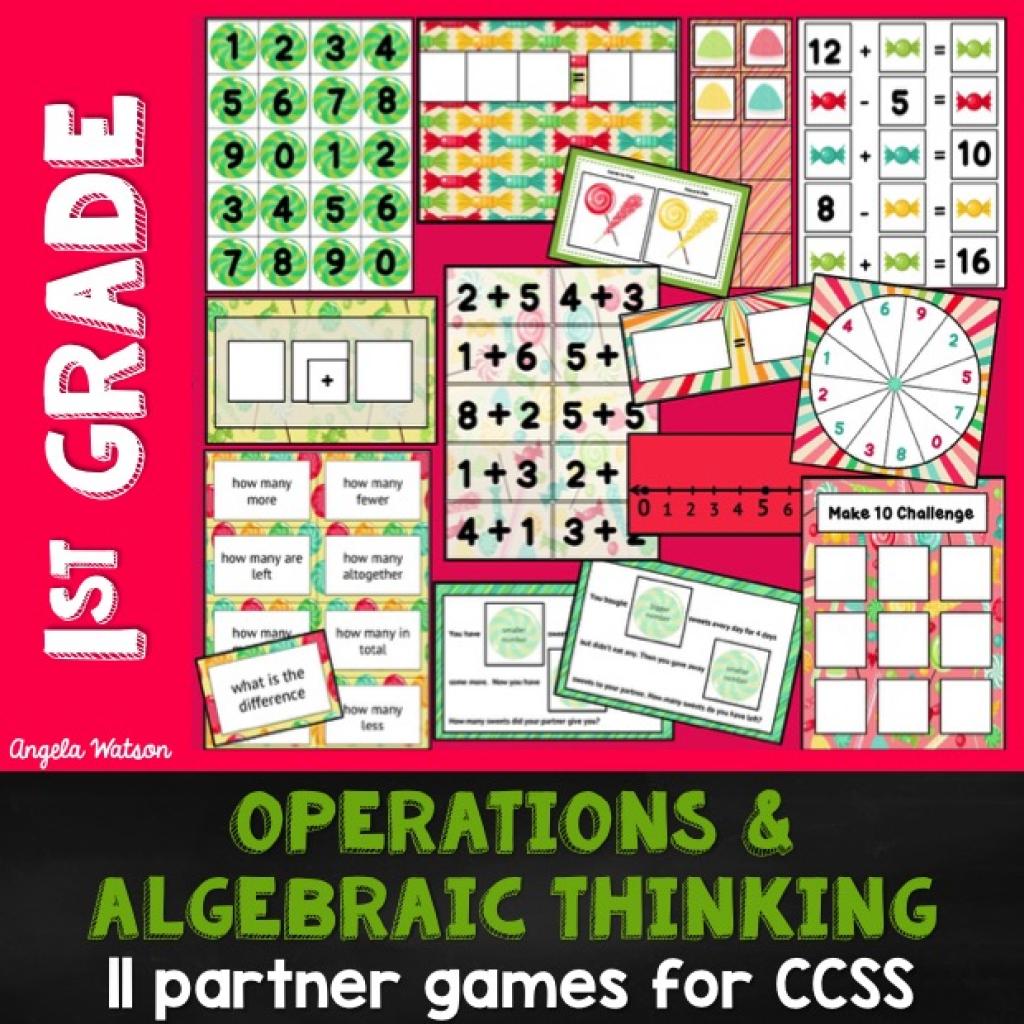






I think this idea would work beautifully with middle level kids, too, and will you be designing any ELA games, or could you design a few just to get me started? Teachers who read your blog could each contribute a few games at their level, and we could develop a giant file of them together!
Julie–
You could also use a regular game board with ELA task cards. Kids roll a die and advance if they get the answer to the card they’ve drawn correct.
Good idea, Nancy! Julie, I will add ELA games to my list of things to create. It’s a pretty long list so far, and I doubt I’ll get to it anytime soon, but I’ll do my very best! 🙂
Do you have plans to create kindergarten math partner games?
I second Julie’s suggestion. I would love to see math games for the middle level as well. I teach remedial math for Grades 6-8 in 20 minute blocks and try to use games often. I can vouch for their effectiveness as a reinforcement tool, as a teaching strategy, and as a formative assessment resource. Most of the games I use either came directly or were adapted from resources I have found on TPT.
Let me see what I can do about that. I have not taught middle school math and need to get together a team of teachers to consult with and make sure the games are developmentally appropriate, but I’ll work on it!
I would be glad to be part of such a team! Please feel free to contact me if interested 🙂
I’m with Julie and Lynne! I would love to see more games for middle school. I know and understand personally the importamce of reinforcing number sense in the elementary years. This helps drastically when students get to middle school. Middle school students LOVE to play in order to learn as well. They may try and act like they are told old for that kind of learning, but deep down, they enjoy it. I do not have the time to sit sown and create games for my students, so I am willing to pay if someone else has created them. There are a lot of games I have purchased and then my creative juicies begin to flow, so I tweak them according to my students’ abilities.
Sounds like this is a huge need for middle school! Thank you for letting me know. I’ll see what I can do!
I have tried differentiated ELA groups, and it has made me crazy! So many students who struggle to stay on task and keep the noise level down. I have a headache when it’s over! Do you have anything like this set up for ELA? I would love it!!
Great idea! I won’t be able to work on that anytime soon, but I’ll add it to my list!
I teach 4th grade students on the autism spectrum. I can’t wait to start this. My only concern is what to do with 3 students: 1 refuses to work..1 is an extremely (EXTREMELY) slow processor, and a 3rd is very capable, but doesn’t like to work with others. Any suggestions on an alternative activity for them? If I make them join in the 10 minutes can quickly turn into 30 with meltdowns.
Could you maybe work with these students yourself and play the games as a foursome? Or pair them up with the other students as normal, and just spend more time assisting/modeling those pairs? I suppose another way would be to only have one set of students playing the games at a time, and have the others work on something else, so that you can give your full attention to those who are playing.